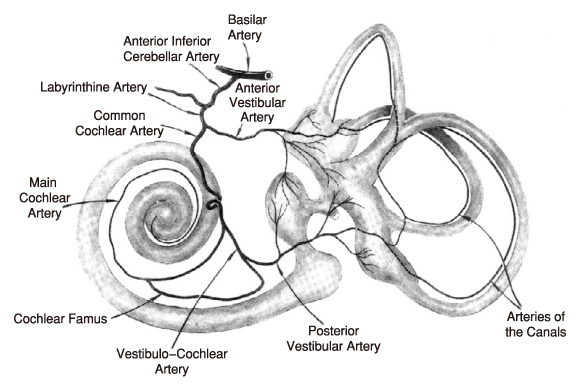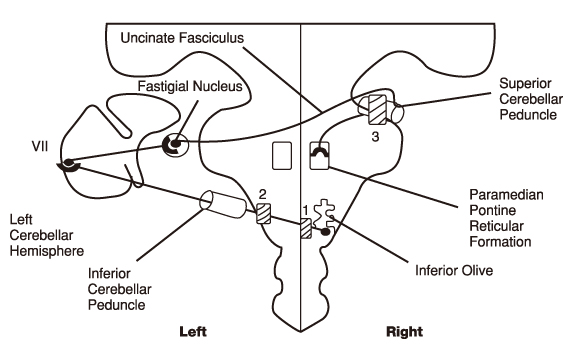J Korean Med Assoc.
2008 Nov;51(11):1016-1024. 10.5124/jkma.2008.51.11.1016.
Vertigo due to Stroke
- Affiliations
-
- 1Department of Neurology, Keimyung University College of Medicine, Korea. hlee@dsmc.or.kr
- 2Department of Neurology, Dankook University College of Medicine, Korea. neurokji@yahoo.co.kr
- KMID: 2137744
- DOI: http://doi.org/10.5124/jkma.2008.51.11.1016
Abstract
- Episodic vertigo frequently occurs in patients suffering from transient ischemia in the distribution of the vertebrobasilar circulation (i.e., vertebrobasilar insufficiency). It may occur in isolation, with other symptoms of vertebrobasilar insufficiency or with persisting symptoms and signs of the infarction of the brain stem and/or cerebellum. Typical attacks of ischemic vertigo are abrupt in onset and last minutes. Ischemic stroke in the distribution of posterior circulation commonly develops acute onset of spontaneous prolonged vertigo and imbalance. As many as 25% of patients with risk factors for stroke who present to an emergency medical setting with isolated, severe vertigo, nystagmus, and postural instability have an infarction of the caudal cerebellum (i.e., pseudo-vestibular neuritis). Since the head thrust test can be performed at the bedside with no requirement of special equipments, it is invaluable for separating 'pseudovestibular neuritis' from true vestibular neuritis. Physicians who evaluate stroke patients should be trained to perform and interpret the result of the head impulse test. Since the inner ear is supplied by the vertebrobasilar circulation, inner ear symptoms are common with ischemia in the distribution. We briefly reviewed the clinical symptoms and neurological examinations of stroke presenting with vertigo, especially focusing on ischemic stroke of the vertebrobasilar territory.
Keyword
MeSH Terms
Figure
Reference
-
1. Korea National Stastical Office. Statistical Yearbook. 2002.2. Grad A, Baloh RW. Vertigo of vascular origin: clinical and electronystagmographic features in 84 cases. Arch Neurol. 1989. 46:281–284.3. Oas JG, Baloh RW. Vertigo and the anterior inferior cerebellar artery syndrome. Neurology. 1992. 42:2274–2279.
Article4. Lee H, Sohn SI, Jung DK, Cho YW, Lim JG, Yi SD, Lee SR, Sohn CH, Baloh RW. Sudden deafness and anterior inferior cerebellar artery infarction. Stroke. 2002. 33:2807–2812.
Article5. Perman HB, Kimura RS, Fernandez C. Experiments on temporal obstruction of the internal auditory artery. Laryngscope. 1959. 69:591–613.6. Kim JS, Lopez I, DiPatre PL, Liu F, Ishiyama A, Baloh RW. Internal auditory artery infarction: clinicopathologic correlation. Neurology. 1999. 52:40–44.
Article7. Fife TD, Baloh RW, Duckwiler GR. Isolated dizziness in vertebrobasilar insufficiency: clinical features, angiography, and follow-up. J Stroke Cerebrovasc Dis. 1994. 4:4–12.
Article8. Lee H, Cho YW. Auditory disturbance as a prodrome of anterior inferior cerebellar artery infarction. J Neurol Neurosurg Psychiatry. 2003. 74:1644–1648.
Article9. Lindsay JR, Hemenway WG. Postural vertigo due to unilateral sudden partial loss of vestibular function. Ann Otol Rhinol Laryngol. 1956. 65:692–706.
Article10. Brandt T. Brandt Th, editor. Stroke and vertigo. Vertigo its multisensory syndromes. 2002. 2nd ed. London, England: Springer-Verlag;307–324.
Article11. Deiterich M, Brandt T. Ocular torsion and tilt of subjective visual vertical are sensitive brainstem signs. Ann Neurol. 1993. 33:292–299.
Article12. Munro NAR, Gaymard B, Rivaud S. Upbeat nystagmus in a patient with a small medullary infarct. J Neurol Neurosurg Psychiatry. 1993. 56:1126–1128.
Article13. Amarecnco P, Rolullet E, Hommel M, Chain P, Marteau R. Infarction in the territory of the medial branch of the posterior inferior cerebellar artery. J Neurol Neurosurg Psychiatry. 1990. 53:731–735.
Article14. Lee H, Whitman GT, Lim JG, Lee SD, Park YC. Bilateral sudden deafness as a prodrome of anterior inferior cerebellar artery infarction. Arch Neurol. 2001. 58:1287–1289.
Article15. Hotson JR, Baloh RW. Differentiating between peripheral and central causes of vertigo. N Engl J Med. 1998. 339:680–685.16. Norrving B, Magnusson M, Holtas S. Isolated acute vertigo in the elderly; vestibular or vascular disease? Acta Neurol Scand. 1995. 91:43–48.
Article17. Lee H, Yi HA, Cho YW, Sohn CH, Whitman GT, Ying S, Baloh RW. Nodulus infarction mimicking acute peripheral vestibulopathy. Neurology. 2003. 60:1700–1702.
Article18. Lee H, Cho YW. A case of Isolated nodulus infarction presenting as a vestibular neuritis. J Neurol Sci. 2004. 221:117–119.
Article19. Lee H. Diagnosis and tretment of acute spontaneous vertigo. proceedings in neurologic symposium. 2003. Seoul National University Hospital. 47–56.20. Westheimer G, Blair SM. Synkinesis of head and eye movements evoked by brain stimulation in the alert monkey. Exp Brain Res. 1975. 24:89–95.21. Dieterich M, Brandt T. ocular torsion and perceived vertical in oculomotor, trochlear and abducens nerve palsies. Brain. 1993. 116:1095–1104.
Article22. Halmagri GM, Brandt T, Dieterich m, Curthoys IS, Stark R, Hoyt WF. Tonic contraversive tilt reaction with unilateral meso-diencephalic lesion. Neurology. 1990. 40:1503–1509.23. Mossman S, Halmagyi M. Partial ocular tilt reaction with to unilateral cerebellar lesion. Neurology. 1997. 49:491–493.
Article24. Lee H, Lee SY, Lee SR, Park BR, Baloh RW. OTR and anterior inferior cerebellar artery syndrome. J Neurol Neurosurg Psychiatry. 2005. 76:1742–1743.25. Macdonell RA, Kalnins RM, Donnan GA. Cerebellar infarction: natural history, prognosis, and pathology. Stroke. 1987. 18:849–855.
Article26. Amarenco P. The spectrum of cerebellar infarctions. Neurology. 1991. 41:973–979.
Article27. Kase CS, Norrving B, Levine SR, Babikian VL, Chodosh EH, Wolf PA, Welch KM. Cerebellar infarction: clinical and anatomic observations in 66 cases. Stroke. 1993. 24:76–83.
Article28. Baloh RW. Differentiating between peripheral and central causes of vertigo. J Neurol Sci. 2004. 221:3.
Article



